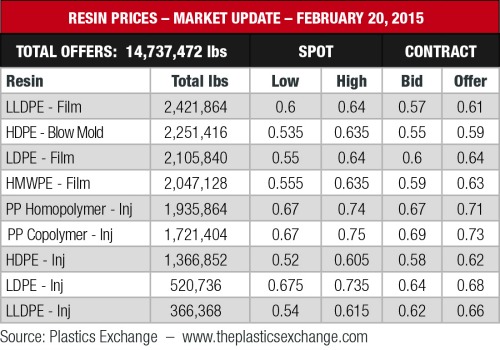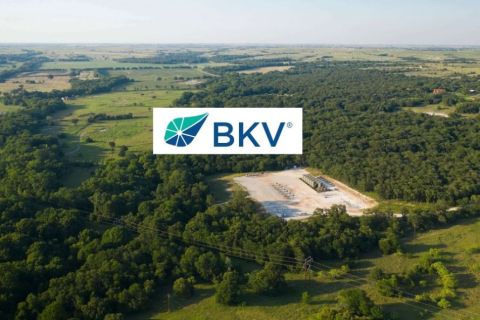
The Siberian blast that hit the East Coast and Midwest the week of Feb. 16 sent natural gas prices surging upward at Transco and Algonquin Citygate hubs, but overall prices were relatively flat. Considering that this blast caused temperatures throughout the country to reach their lowest levels for the month of February in more than a decade, the lack of a sustained price surge is a strong signal of a well-supplied market compared to last year when supplies had trouble getting to demand centers.
The U.S. Energy Information Administration reported that gas storage withdrawal was only 111 billion cubic feet (Bcf) the week of Feb. 13, which is within normal levels. This left the storage level at 2.157 trillion cubic feet (Tcf), which was 46% greater than the 1.479 Tcf level posted during last year’s frigid temperatures and 3% greater than the five-year average of 2.099 Tcf.
“The withdrawals were much lower than the 230 Bcf reported in the same week last year and significantly below the five-year average of 188 Bcf … Boosted by cold weather and low relative prices, coal to gas switching has been robust at these prices in some regions, while in other regions increased renewable generation has displaced gas-fired generation in the supply stack,” Barclays Capital said in a Feb. 16 research note.
On a longer-term basis, prices could experience an uptick as Cheniere Energy Inc. announced that its Sabine Pass LNG export terminal may deliver its first cargoes in December 2015. This would be ahead of the projected timeline of first-quarter 2016.
While gas prices were flat, propane prices experienced notable increases at both Conway and Mont Belvieu as a result of increased heating demand. Both hubs saw prices improve by 9% with the Mont Belvieu price hitting 58 cents per gallon (/gal), its highest price since the week of Nov. 26 when it was 69 cents/gal. The Conway price rose to 54 cents/gal, the highest the price has been since it was 57 cents/gal the week of Dec. 3.
Crude oil stock levels remain high, but the market is reacting well to the oversupply situation as rig counts have fallen and gasoline demand is increasing due to the lower prices, especially in the U.S. “Since the beginning of this year, implied product demand has been 3.4% higher year-on-year vs. 2014, driven by higher gasoline, distillate and jet demand,” Barclays Capital reported. “Absent the recent spell of bad weather in the Northeast and Midwest, product demand could arguably be even higher. This has helped support product prices, strengthen cracks and increase refinery runs while the market was searching for a floor.”
As West Texas Intermediate crude prices rose above the $50 per barrel (/bbl) threshold, they have ushered in improvements to heavy NGL prices. The biggest increase was for Conway isobutane, which can get short quickly due to the limited isomerization units available in the region. Prices rose 14% to 85 cents/gal, its highest price since the week of Dec. 3 when it was 95 cents/gal. During the last few years in February, isobutane experienced similar upticks at the hub as this movement is fast becoming the norm.
Overall the theoretical NGL bbl rose at similar rates at both hubs as the Conway price rose 6% to $22.89/bbl with a 9% increase in margin to $13.18/bbl while the Mont Belvieu price rose 5% to $23.05/bbl with a 10% increase in margin to $13.18/bbl.
The most profitable NGL to make at both hubs was C5+ at 87 cents/gal at both hubs. This was followed, in order, by isobutane at 58 cents/gal at Conway and 43 cents/gal at Mont Belvieu; butane at 39 cents/gal at Conway and 40 cents/gal at Mont Belvieu; propane at 30 cents/gal at Conway and 34 cents/gal at Mont Belvieu; and ethane at negative 1 cent/gal at Conway and nil at Mont Belvieu.
The National Weather Service anticipates temperatures to increase the week of Feb. 25 from the lows caused by the Siberian blast, but to remain colder-than-normal for this time of year. This should help work off even more excess gas and propane as heating demand remains strong in the last few weeks of winter.



Recommended Reading
Woodside Reports Record Q3 Production, Narrows Guidance for 2024
2024-10-17 - Australia’s Woodside Energy reported record production of 577,000 boe/d in the third quarter of 2024, an 18% increase due to the start of the Sangomar project offshore Senegal. The Aussie company has narrowed its production guidance for 2024 as a result.
Energy Sector Sees Dramatic Increase in Private Equity Funding
2024-11-21 - In a 10-day period, private equity firms announced almost $20 billion in energy funding. Is an end in sight for the fossil fuel capital drought?
Twenty Years Ago, Range Jumpstarted the Marcellus Boom
2024-11-06 - Range Resources launched the Appalachia shale rush, and rising domestic power and LNG demand can trigger it to boom again.
Exclusive: How E&Ps Yearning Capital can Stand Out to Family Offices
2024-10-15 - 3P Energy Capital’s Founder and Managing Partner Christina Kitchens shares insight on the “educational process” of operators looking at opportunities in the U.S. and how E&Ps looking for capital can interest family offices, in this Hart Energy Exclusive interview.
BKV Prices IPO at $270MM Nearly Two Years After First Filing
2024-09-25 - BKV Corp. priced its common shares at $18 each after and will begin trading on Sept. 26, about two years after the Denver company first filed for an IPO.
Comments
Add new comment
This conversation is moderated according to Hart Energy community rules. Please read the rules before joining the discussion. If you’re experiencing any technical problems, please contact our customer care team.





